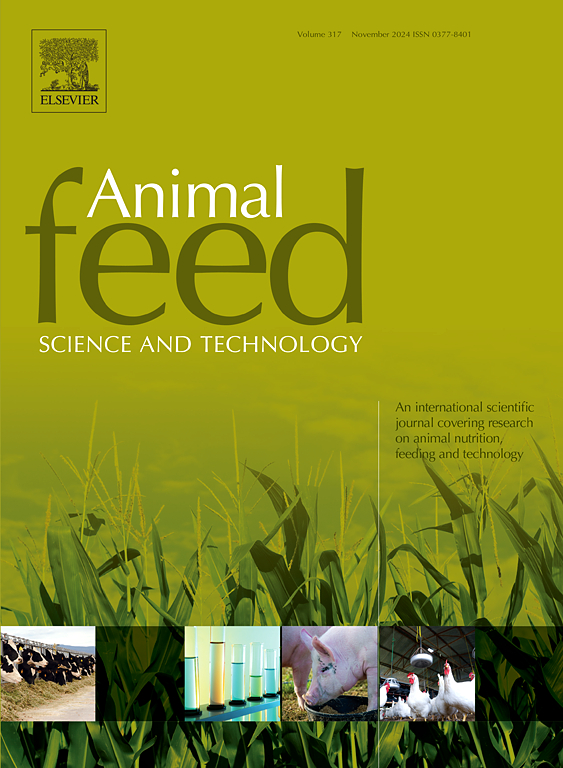循环水养殖系统中新断奶坦巴鱼幼鱼的摄食率
IF 2.5
2区 农林科学
Q1 AGRICULTURE, DAIRY & ANIMAL SCIENCE
引用次数: 0
摘要
确定鱼的最佳摄食率对促进鱼的生长和饲料效率、避免浪费和保持水质至关重要。内源因素和养殖环境会影响摄食率。因此,本研究旨在研究5种不同投喂率对循环水养殖系统中新断奶大斑鲷幼鱼水质、生长性能和基因表达的影响。试验5种取食率,分别为5 %、10 %、15 %、20 %和25 %,共3个重复,取食28 d。溶解氧水平仅在投喂生物量为5 %的鱼缸中较高。饲喂生物量为10 %、15 %、20 %和25 %时,总体长、长增、长增率、体重、增重、增重率和特定生长率最大。然而,分段回归分析确定,最佳理论总长度和体重对应的取食率分别为10.35 %和11.87 %。Ghrelin和leptin与摄食率的增加成正比,而myod和myog基因在不同摄食率下的表达没有差异。为了获得最佳的饲料利用率和生产效率,我们得出结论,在循环水养殖系统中,在苗期饲喂11.87 %的幼鱼是最合适的。本文章由计算机程序翻译,如有差异,请以英文原文为准。
Feeding rate for newly weaned tambaqui (Colossoma macropomum) juveniles in a recirculating aquaculture system
Determining the optimal feeding rate for fish is crucial to promote growth and feed efficiency, avoid wastage, and maintain water quality. Endogenous factors and the farming environment can influence the feeding rate. Therefore, the present study aimed to investigate the effects of five different feeding rates on water quality, growth performance and gene expression in newly weaned tambaqui (Colossoma macropomum) juveniles reared in a recirculating aquaculture system. Five feeding rates were tested in triplicate: 5 %, 10 %, 15 %, 20 %, and 25 % of biomass daily for 28 days. Dissolved oxygen levels were higher only in the fish tanks fed with 5 % of biomass. The greatest total length, length gain, length gain rate, weight, weight gain, weight gain rate, and specific growth rate were observed in tambaqui juveniles fed with 10 %, 15 %, 20 %, and 25 % of biomass, respectively. However, segmented regression analysis determined that the optimal theoretical total length and weight corresponded to feeding rates of 10.35 % and 11.87 % of biomass, respectively. Ghrelin and leptin were directly proportional to the increase in feeding rate, although there was no difference in the expression of myod and myog genes in tambaqui fed at different feeding rates. For optimal feed utilization and productivity, we conclude that feeding tambaqui juveniles at 11.87 % of biomass per day is most suitable for this species during the nursery phase in a recirculating aquaculture system.
求助全文
通过发布文献求助,成功后即可免费获取论文全文。
去求助
来源期刊

Animal Feed Science and Technology
农林科学-奶制品与动物科学
CiteScore
6.00
自引率
6.20%
发文量
266
审稿时长
3 months
期刊介绍:
Animal Feed Science and Technology is a unique journal publishing scientific papers of international interest focusing on animal feeds and their feeding.
Papers describing research on feed for ruminants and non-ruminants, including poultry, horses, companion animals and aquatic animals, are welcome.
The journal covers the following areas:
Nutritive value of feeds (e.g., assessment, improvement)
Methods of conserving and processing feeds that affect their nutritional value
Agronomic and climatic factors influencing the nutritive value of feeds
Utilization of feeds and the improvement of such
Metabolic, production, reproduction and health responses, as well as potential environmental impacts, of diet inputs and feed technologies (e.g., feeds, feed additives, feed components, mycotoxins)
Mathematical models relating directly to animal-feed interactions
Analytical and experimental methods for feed evaluation
Environmental impacts of feed technologies in animal production.
 求助内容:
求助内容: 应助结果提醒方式:
应助结果提醒方式:


